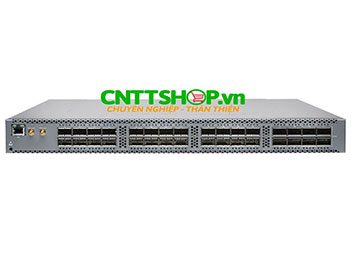| Hardware |
| CPU |
1.8 GHz quad-core Intel CPU |
| RAM |
16 GB |
| Storage |
64 GB SSD storage |
| Switching Capacity |
2.56 Tbps/1.44 Bpps |
| Weight |
24.6 lb (11.16 kg) |
| Dimensions (HxWxD) |
1.72 x17.36 x 20.48 in (4.37 x 44.09 x 52.02 cm) |
| Switching mode |
Cut-through and store-and-forward |
| Airflow |
back-to-front |
| Power Consumption |
Max load: 340 W,
Typical load: 290 W,
Idle load: 250 W |
| Interface Options |
- 1GbE SFP: N/A
- 10GbE QSFP+: 96 (with breakout cable)
- 40GbE QSFP+: 32
- 100GbE QSFP28: 4
• Each QSFP+ port can be configured as a 4 x 10GbE interface or as a 40 Gbps port
• Each QSFP28 port can be configured as a 4 x 10GbE interface a 40 Gbps port or as a 100 Gbps port
• 1 USB 2.0 port
• 1 RS-232 console port
• 2 management ports: 2x SFP fiber ports or 1x RJ-45 and 1x copper SFP ports |
| Rack Installation Kit |
Versatile four post mounting options for 19-in server rack or datacom rack |
| Power Supply and Fan Modules |
• Dual redundant (1+1) and hot-pluggable power supplies
• -36 to -72 V DC power
• Redundant (N+1) and hot-pluggable fan modules for frontto-back and back-to-front airflow |
| Performance Scale (Unidimensional) |
• MAC addresses per system: 288,000
• VLAN IDs: 4,093
• Number of link aggregation groups (LAGs): 104
• Number of ports per LAG: 32
• Firewall filters
- Ingress filters: 6,142
- Egress filters: 1,022
• IPv4 unicast routes: 128,000 prefixes; 208,000 host routes; 64 ECMP paths
• IPv4 multicast routes: 104,000
• IPv6 multicast routes: 52,000
• IPv6 unicast routes: 84,000 prefixes
• ARP entries: 48,000
• Jumbo frame: 9,216 bytes
• Spanning Tree Protocol (STP)
- Multiple Spanning Tree Protocol (MSTP) Instances: 64
- VLAN Spanning Tree Protocol (VSTP) Instances: 253
• Traffic mirroring
- Mirroring destination ports per switch: 4
- Maximum number of mirroring sessions: 4
- Mirroring destination VLANs per switch: 4 |
| Software Features Supported |
| Layer 2 Features |
• STP—IEEE 802.1D (802.1D-2004)
• Rapid Spanning Tree Protocol (RSTP) (IEEE 802.1w); MSTP (IEEE 802.1s)
• Bridge protocol data unit (BPDU) protect
• Loop protect
• Root protect
• RSTP and VSTP running concurrently
• VLAN—IEEE 802.1Q VLAN trunking
• The Routed VLAN Interface (RVI)
• Port-based VLAN
• Private VLAN (PVLAN)
• VLAN translation
• Static MAC address assignment for interface
• Per VLAN MAC learning (limit)
• MAC learning disable
• Link Aggregation and Link Aggregation Control Protocol (LACP) (IEEE 802.3ad) |
| Link Aggregation |
• Multi-chassis link aggregation (MC-LAG)
• Redundant Trunk Group (RTG)
• LAG load sharing algorithm—bridged or routed (unicast or multicast) traffic:
- IP: SIP, Dynamic Internet Protocol (DIP), TCP/UDP source port, TCP/UDP destination port
- Layer 2 and non-IP: MAC SA, MAC DA, Ethertype, VLAN ID, source port |
| Layer 3 Features (IPv4) |
• Static routing
• Routing protocols (RIP, OSPF, IS-IS, BGP)
• Virtual Router Redundancy Protocol (VRRP)
• Bidirectional Forwarding Detection (BFD) protocol
• Virtual router
• Dynamic Host Configuration Protocol (DHCP) relay
• Proxy Address Resolution Protocol (ARP) |
| Multicast Features |
• Internet Group Management Protocol (IGMP): v1, v2 , V3
• IGMP snooping: v1, v2, v3
• IGMP Filter
• PIM-SM
• Multicast Source Discovery Protocol (MSDP) |
| Security and Filters |
• Secure interface login and password
• RADIUS
• TACACS+
• Ingress and egress filters: Allow and deny, port filters, VLAN filters, and routed filters, including management port filters
• Filter actions: Logging, system logging, reject, mirror to an interface, counters, assign forwarding class, permit, drop, police, mark
• SSH v1, v2
• Static ARP support
• Storm control, port error disable, and autorecovery
• IP source guard
• Dynamic ARP Inspection (DAI)
• Sticky MAC address
• DHCP snooping |
| Quality of Service (QoS) |
• L2 and L3 QoS: Classification, rewrite, queuing
• Rate limiting:
- Ingress policing: 1 rate 2 color, 2 rate 3 color
- Egress policing: Policer, policer mark down action
- Egress shaping: Per queue on each port
• 12 hardware queues per port (8 unicast and 4 multicast)
• Strict priority queuing (LLQ), smoothed deficit weighted round-robin (SDWRR), weighted random early detection (WRED), weighted tail drop
• 802.1p remarking
• Layer 2 classification criteria: Interface, MAC address, Ethertype, 802.1p, VLAN
• Congestion avoidance capabilities: WRED
• Trust IEEE 802.1p (ingress)
• Remarking of bridged packets |
| Data Center Bridging (DCB) |
• Priority-based flow control (PFC)—IEEE 802.1Qbb
• Enhanced Transmission Selection (ETS)—IEEE 802.1Qaz
• Data Center Bridging Exchange Protocol (DCBX), DCBx FCoE, and iSCSI type, length, and value (TLVs) |
| High Availability |
• Bidirectional Forwarding Detection (BFD)
• Uplink failure detection |
| MPLS |
• Static label-switched paths (LSPs)
• RSVP-based signaling of LSPs
• LDP-based signaling of LSPs
• LDP tunneling (LDP over RSVP)
• MPLS class of service (CoS)
• MPLS LSR support
• IPv6 tunneling (6PE) (via IPv4 MPLS backbone)
• IPv4 L3 VPN (RFC 2547, RFC 4364) |
| Server Virtualization Management and SDN-Related Protocols |
• VXLAN OVSDB
• EVPN VXLAN
• OpenFlow 1.3 client |
| Management and Operations |
• Contrail Networking
• Role-based CLI management and access
• CLI via console, telnet, or SSH
• Extended ping and traceroute
• Junos OS configuration rescue and rollback
• Image rollback
• SNMP v1/v2/v3
• Junos XML management protocol
• sFlow v5
• Beacon LED for port and system
• Zero touch provisioning (ZTP)
• OpenStack Neutron Plug-in
• Python
• Junos OS event, commit, and OP scripts
• Junos Telemetry Interface |
| Traffic Mirroring |
• Port-based
• LAG port
• VLAN-based
• Filter-based
• Mirror to local
• Mirror to remote destinations (L2 over VLAN) |
| Standards Compliance |
| IEEE Standard |
IEEE standard, IEEE 802.1D, IEEE 802.1w, IEEE 802.1, IEEE 802.1Q, IEEE 802.1p, IEEE 802.1ad, IEEE 802.3ad, IEEE 802.1AB, IEEE 802.3x, IEEE 802.1Qbb, IEEE 802.1Qaz |
| T11 Standards |
INCITS T11 FC-BB-5 |
| Safety |
• CAN/CSA-C22.2 No. 60950-1 Information Technology Equipment—Safety
• UL 60950-1 (Second Edition) Information Technology Equipment—Safety
• IEC 60950-1 Information Technology Equipment—Safety (All country deviations): CB Scheme report
• EN 60825-1 Safety of Laser Products—Part 1: Equipment Classification |
| NEBS |
• GR-63-Core Network Equipment, Building Systems (NEBS) Physical Protection
• GR-1089-Core EMC and Electrical Safety for Network Telecommunications Equipment |
| EMC |
• FCC 47CFR, Part 15 Class A USA Radiated Emissions
• ICES-003 Class A
• EN 55022 Class A European Radiated Emissions
• CISPR 22 Class A
• EN 55032 Class A
• CISPR 32 Class A
• EN 55024
• CISPR 24
• EN 300 386
• VCCI Class A Japanese Radiated Emissions
• BSMI CNS 13438 Taiwan Radiated Emissions
• AS/NZS CISPR22 • AS/NZS CISPR32 |
| Environmental Ranges |
• Operating temperature: 32° to 104° F (0° to 40° C)
• Storage temperature: -40° to 158° F (-40° to 70° C)
• Operating altitude: up to 2,000 (610 m)
• Relative humidity operating: 5% to 90% (noncondensing)
• Relative humidity non-operating: 0% to 95% (noncondensing) |
 Switch
Switch Wifi - Access Point
Wifi - Access Point Firewall
Firewall Router
Router Module Quang
Module Quang![Module Quang Cisco]() Module Quang Cisco
Module Quang Cisco![Module quang HPE]() Module quang HPE
Module quang HPE![Module quang Maipu]() Module quang Maipu
Module quang Maipu![Module quang Brocade]() Module quang Brocade
Module quang Brocade![Module quang Fortinet]() Module quang Fortinet
Module quang Fortinet![Module quang Aruba]() Module quang Aruba
Module quang Aruba![Module quang OEM]() Module quang OEM
Module quang OEM![Module quang Juniper]() Module quang Juniper
Module quang Juniper![Module quang Dell]() Module quang Dell
Module quang Dell![Module quang Palo Alto]() Module quang Palo Alto
Module quang Palo Alto![Module quang Huawei]() Module quang Huawei
Module quang Huawei![Module quang Arista]() Module quang Arista
Module quang Arista![Module quang F5]() Module quang F5
Module quang F5![Module quang H3C]() Module quang H3C
Module quang H3C![Module Quang Allied Telesis]() Module Quang Allied Telesis
Module Quang Allied Telesis![Module quang SonicWall]() Module quang SonicWall
Module quang SonicWall![Module quang Mikrotik]() Module quang Mikrotik
Module quang Mikrotik![Module quang Handar]() Module quang Handar
Module quang Handar Máy chủ (Server)
Máy chủ (Server) Thiết bị lưu trữ (SAN, NAS)
Thiết bị lưu trữ (SAN, NAS) Load Balancing
Load Balancing Video Conferencing
Video Conferencing Phụ kiện máy chủ
Phụ kiện máy chủ Thiết Bị IoT
Thiết Bị IoT Phụ Kiện Mạng
Phụ Kiện Mạng




.png)
























Bạn đang cần tư vấn về sản phẩm: QFX5110-32Q-DC-AFI ?